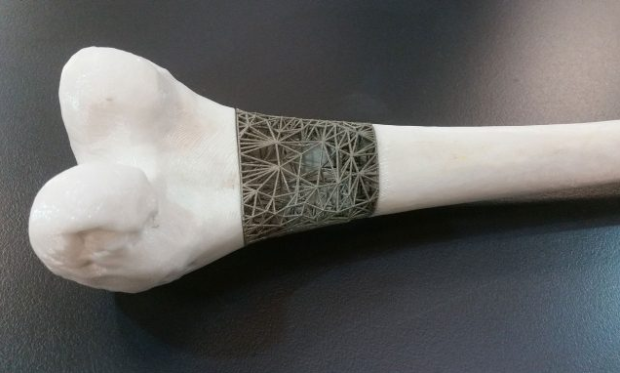With the development and adoption of medical technology like x-rays, anaesthesia and antisepsis in the mid to late 1800’s that allowed doctors to treat broken bones surgically, the science of fixing bone breaks took a major leap forward. The advancements meant that a broken bone wasn’t as likely to end in infection or death, especially in the case of complex breaks to the pelvis and hip. But understanding how to rebuild a broken bone surgically can’t really make it grow back faster, so even now the recovery time for many breaks can mean weeks or months of healing and restricted movements. In that regard, not much has changed for us since the 19th century, although that could all change soon thanks to additive manufacturing technology.
Healing simple bone breaks is relatively straightforward and often doesn’t require any surgery because the bone can be reset orthopaedically. Once the broken bones are lined up together, they are set and held in place with a cast and a brace, and the bones start to knit themselves back together. But for more complex breaks, surgeons often need help encouraging broken bones to regrow and heal themselves. Surgeons will often need to insert pins, screws or implants to hold breaks together fast while they heal.
“If you have a defect in a bone, and if the bone defect is beyond a certain size, younger connective tissues forms, but it’s not bone. You need a bridge,” Paul James, Associate Professor of Biology at Ohio’s Miami University and one of the lead researchers on a project to 3D print bone scaffolds, explained to The Miami Student.
These bridges or scaffolds were developed to encourage broken bones to not only heal faster and stronger, but to offer extra support and stability during the healing process itself. This is the work of a team of dedicated researchers in the Engineering Building at Miami University, to find ways to regrow better bones using 3D printing technology. The team has been lead by biologist Paul James and professor of chemical, paper and biomedical engineering Amy Yousef since the project was began in 2009. The goal of the project is simple. James and Yousef want to find a way to 3D print the ideal scaffolding and bone replacements to help heal missing or heavily traumatized bone.
Most bone implants, bridges and scaffolds are made from metals like titanium, both for their durability and lack of toxicity. However, the team of researchers are working with other medical materials and polymers that can be bioprinted using a large medical 3D printer called a 3D-Bioplotter, made by EnvisionTEC. Using the 3D-Bioplotter, the scaffolds are 3D printed and then exposed to a series of solvents and solutions that create micro channels and micro holes that foster the growth of bone and blood vessels and allow fluids to easily move between cells. The solvents also create nanoscopic pockmarks all over the surface of the scaffold, which makes it easier for growing biological cells to adhere and quickly replicate. The completed scaffolds will also be seeded with cellular material that will further encourage the growth of the bone.
Research like this is an important step in the development of our treatment of broken and damaged bones. Being able to repair even highly complex breaks and wounds would benefit everyone, but it would especially impact veterans, who often lose limbs to this type of trauma. Thankfully the project has been funded through 2019, so we could soon be seeing these types of implants all over the world.“This is where Dr. Zhang comes in. We want to optimize the number and size of the pores while maintaining a certain thickness,” James said of Jing Zhang, the Miami statistics professor who is assisting with finding the delicate balance between the strength and durability of the scaffold and the ability to encourage cell adhesion.
Discuss this and other 3D printing topics at 3DPrintBoard.com or share your thoughts below.
Subscribe to Our Email Newsletter
Stay up-to-date on all the latest news from the 3D printing industry and receive information and offers from third party vendors.
You May Also Like
Precision at the Microscale: UK Researchers Advance Medical Devices with BMF’s 3D Printing Tech
University of Nottingham researchers are using Boston Micro Fabrication‘s (BMF) 3D printing technology to develop medical devices that improve compatibility with human tissue. Funded by a UK grant, this project...
3D Printing Webinar and Event Roundup: April 21, 2024
It’s another busy week of webinars and events, starting with Hannover Messe in Germany and continuing with Metalcasting Congress, Chinaplas, TechBlick’s Innovation Festival, and more. Stratasys continues its advanced training...
3D Printing Webinar and Event Roundup: March 17, 2024
It’s another busy week of webinars and events, including SALMED 2024 and AM Forum in Berlin. Stratasys continues its in-person training and is offering two webinars, ASTM is holding a...
3D Printed Micro Antenna is 15% Smaller and 6X Lighter
Horizon Microtechnologies has achieved success in creating a high-frequency D-Band horn antenna through micro 3D printing. However, this achievement did not rely solely on 3D printing; it involved a combination...
































